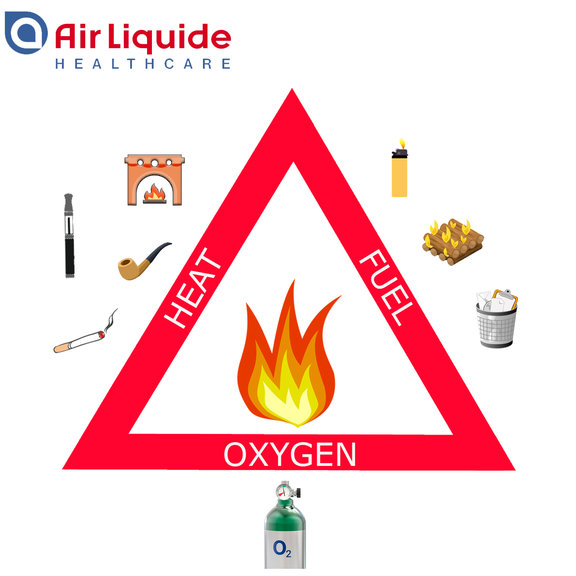Home Oxygen Safety
Home oxygen therapy is safe as long as you follow a few simple rules
Fire Risk
The Fire Triangle
To start a fire, three things are needed:
- Fuel - something to burn
- Heat or a spark - something to set it alight
- Oxygen - to support the fire and keep it going
Materials burn much faster in oxygen than in air alone, it is therefore important that you:
- NEVER smoke or let anyone else smoke near you when using your oxygen equipment, this includes E-Cigarettes
- NEVER charge an E-Cigarette or similar device close to you when using your oxygen equipment or near the equipment itself
- NEVER use your oxygen equipment near an open fire or naked flames, such as matches, lighters, gas cookers or candles (within 3 metres)
- NEVER use oxygen near other heat sources such as electric or gas heaters or boilers (within 1.5 metres)
- NEVER use any oxygen equipment that has been involved in a fire or accident. If your oxygen equipment is involved in a fire you should contact the Patient Support Team to inform Air Liquide
Oxygen Saturation (Enrichment)
When your oxygen equipment is turned on, oxygen can build up unnoticed on materials such as clothing, hair, fabrics, wood and paper. This can cause them to burn more easily if they catch fire. Because of this, you should:
- ALWAYS turn off your oxygen equipment when you are not using it
- ALWAYS use or store your oxygen equipment in a well ventilated area
- NEVER place your oxygen equipment near curtains or cover it with coats, blankets or other materials that may restrict the air circulation around it
- NEVER leave your cannula or mask on the bed or chair when oxygen equipment is switched on
Storage and Usage
You should ALWAYS follow the advice given to you by your Air Liquide healthcare technician about the safest place to store and use your oxygen equipment. It is important that you:
- ALWAYS ensure your oxygen equipment is stored in a well ventilated area, kept clean, dry and away from any sources of heat or fire e.g. convection heaters, gas or electric fires and gas or electric cookers
- NEVER store your oxygen equipment close to paint, oil, grease or any domestic heating gases e.g. in a garage or shed where these items may be stored
- NEVER keep combustible materials near your oxygen equipment e.g. newspapers and magazines and other items that may burn easily
This information applies to all places where you use or store your equipment, and when travelling with it.
Oils and Grease
- Never use oils or grease near your oxygen equipment
- Never use Vaseline or other oil based creams when using your oxygen equipment
- Only use water based soluble creams or products (ask your pharmacist if you are unsure)
- Always make sure your hands are clean when using your home oxygen equipment.
Beware of Tripping Over Your Oxygen Tube
Your Air Liquide healthcare technician will provide you with a safe amount of tubing to meet your needs around the home up to a maximum distance of 15 metres.
You need to be aware that any oxygen tubing is a potential trip hazard for you and anyone else in your home, it is your responsibility to remain safe whilst using your home oxygen equipment.
- REMEMBER that the tubing is trailing behind you and around your feet. Particular care needs to be taken when moving around your home especially on staircases. You should:
- ALWAYS take care to ensure the tubing does not get kinked, damaged, trapped in doors or crushed under equipment and furniture as this could affect the flow of your oxygen
- ALWAYS ensure your tubing does not pass close to naked flames including gas fires, gas cookers and candles, or hot items such as electric cookers and electric heaters. These could damage or melt the tubing and cut off your oxygen supply or even cause a fire
- NEVER modify or tamper with your own oxygen tubing by adding to it, or changing components
- NEVER remove or tamper with the firebreaks in the tubing
Fire and Rescue Services
Your details will be shared with the local Fire and Rescue Service so that in the unlikely event of a fire, the Fire and Rescue Services know that there is home oxygen equipment at your address.
You may receive a home safety visit from your local Fire and Rescue Service to help manage any risks and plan how to evacuate the building in the event of a fire. If you are contacted by them it is important you allow them to visit your home.
